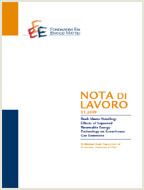Spatial Heat Transport, Polar Amplification and Climate Change Policy

21.01.2016
Q54, Q58, C61
Climate Change, Heat Transport, Polar Amplification, Welfare Maximization, Fossil Fuels, Optimal Taxation
Mitigation, Innovation and Transformation Pathways
Massimo Tavoni
This paper is, to our knowledge, the first paper in climate economics to consider the combination of spatial heat transport and polar amplification. We simplified the problem by stratifying the Earth into latitude belts and assuming, as in North et al. (1981), that the two hemispheres were symmetric. Our results suggest that it is possible to build climate economic models that include the very real climatic phenomena of heat transport and polar amplification and still maintain analytical tractability. We derive optimal fossil fuel paths under heat transport with and without polar amplification. We show that the optimal tax function depends not only on the distribution of welfare weights but also on the distribution of population across latitudes, the distribution of marginal damages across latitudes and cross latitude interactions of marginal damages, and climate dynamics. We also determine optimal taxes per unit of emission and show that, in contrast to the standard results suggesting spatially uniform emission taxes, poorer latitudes should be taxed less per unit emissions than richer latitudes.
***
Suggested citation: Brock, W., A. Xepapadeas, (2016), ‘Spatial Heat Transport, Polar Amplification and Climate Change Policy’, Nota di Lavoro 3.2016, Milan, Italy: Fondazione Eni Enrico Mattei
